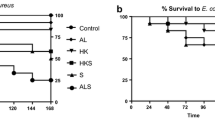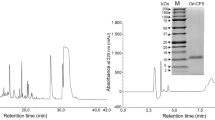Summary
-
1.
Among the bacterial strains Pseudomonas aeruginosa, Serratia marcescens, and Escherichia coli the first one exerts the strongest and the last one the weakest virulence upon Pyrrhocoris apterus and caterpillars of Galleria mellonella.
-
2.
In contrast to caterpillars of Galleria, Pyrrhocoris bugs cannot be actively immunized by injections of a vaccine consisting of heatkilled Pseudomonas bacteria.
-
3.
Passive immunization of Pyrrhocoris by injections of hemolymph taken from immunized Galleria caterpillars does not cause a significant protection from an infection by Pseudomonas bacteria.
-
4.
Active immunity of Galleria caterpillars is already observed 6 hours after vaccination. It culminates 24–48 hours later and is no longer demonstrable on and after the sixth day since vaccination.
-
5.
Actinomycin C does not prevent active immunization of Galleria.
-
6.
Studies on the protein patterns in the hemolymph of Galleria by discelectrophoresis revealed no significant variations of protein components during immunization.
-
7.
Incorporation of 3H-tyrosine in hemolymph fractions was inhibited by vaccinating Galleria, probably by blocking up tyrosine oxidase. The radioactive tyrosine is not, in any case, incorporated in a fraction of immune hemolymph lacking the hemolymph of non-immunized individuals.
-
8.
Lysozyme injections in concentrations of 0.5–1% (in contrast to 3%) into Galleria made them successfully withstand infections from Pseudomonas injected 24 hours later. This immunity could not be observed when the infection took place immediately after lysozyme injection.
Zusammenfassung
-
1.
Von den getesteten Bakterienstämmen Pseudomonas aeruginosa, Serratia marcescens und Escherichia coli hat der erste die höchste, der letzte die geringste Virulenz gegenüber Pyrrhocoris apterus und Galleria-mellonella-Raupen.
-
2.
Pyrrhocoris apterus läßt sich durch Injektion einer Vakzine aus hitzegetöteten Pseudomonas-Bakterien im Gegensatz zu Galleria-Raupen nicht aktiv immunisieren.
-
3.
Eine passive Übertragung des Galleria-Immunfaktors auf Pyrrhocoris apterus ist nicht möglich.
-
4.
Die aktive Immunität von Galleria-Raupen ist 6 h nach der Vakzination feststellbar, erreicht 24–48 h später ihren Höhepunkt und ist 5 d später nicht mehr nachzuweisen.
-
5.
Die Synthese des Immunfaktors von Galleria ist durch Actinomycin C nicht signifikant hemmbar.
-
6.
Das Protein-Elektropherogramm der Hämolymphe von Galleria zeigt im Laufe des Immunisierungsvorganges keine auffälligen Veränderungen der Proteinkomponenten.
-
7.
Die Immunisierung führt bei Galleria zu einer Hemmung der Inkorporation von 3H-Tyrosin, wahrscheinlich durch Blockierung der Tyrosinoxidase. Das radioaktive Tyrosin wird jedenfalls nicht durch eine Fraktion der Immunhämolymphe inkorporiert, die der Normalhämolymphe fehlt.
-
8.
Die Injektion von Lysozym in 0,5–1%iger Lösung (nicht in 3%iger) schützt Galleria vor einer 24 h später (nicht vor einer unmittelbar danach) vorgenommenen Infektion.
Similar content being viewed by others
Literatur
Ambrosius, H., u. R. Lehmann: Beiträge zur Immunbiologie poikilothermer Wirbeltiere. II. Immunologische Untersuchungen an Schildkröten (Testudo hermanni Gmelin). Z. Immun.-Forsch. 128, 81–104 (1964).
—: Beiträge zur Immunbiologie poikilothermer Wirbeltiere. III. Der Einfluß von Adjuvantien auf die Antikörperproduktion von Knochenfischen (Teleostei). Acta biol. med. germ. 14, 830–844 (1965).
—, u. W. Schäker: Beiträge zur Immunbiologie poikilothermer Wirbeltiere. I. Immunologische Untersuchungen an Karpfen (Cyprinus carpio L.). Zool. J. Physiol. 71, 73–88 (1964).
Ballowitz, L.: Die Entwicklung der Blutgruppenmerkmalo und Hämagglutinine mit ontogenetisehen und phylogenetischen Betrachtungen. Ergebn. inn. Med. Kinderheilk. 22, 1–57 (1965).
Bang, F. B.: Serological aspects of immunity in invertebrates. Nature (Lond.) 196, 88–89 (1962).
Bernheimer, A. W., E. Caspari, and A. D. Kaiser: Studies on antibody formation in caterpillars. J. Exp. Zool. 119, 23–35 (1962).
Bettini, S.: Acquired immune response of the house fly, Musca, domestica (Linnaeus), to injected venom of the spider Latrodectus mactans tredecimguttatus (Rossi). J. Invert. Path. 7, 378–383 (1965).
Bisset, K. A.: Bacterial infection and immunity in lower vertebrates and invertebrates. J. Hyg. (Lond.) 45, 128–135 (1947).
Boorman, K. E., u. B. E. Dodd: Blutgruppen-Serologie. Einführung in ihre Theorie, Methodik und praktische Anwendung. Stuttgart: Gustav Fischer 1964.
Boyd, W. C., and H. Bernard: Quantitative changes in antibodies and globulin fractions in sera of rabbits injected with several antigens. J. Immunol. 33, 111–122 (1937).
Briggs, J. D.: Humoral immunity in lepidopterous larvae. J. Exp. Zool. 138, 155–188 (1958).
—: Immunological responses. In: M. Rockstein, Physiology of Insecta, vol. III, p. 259–283. New York and London: Academic Press 1964.
Büchi, J., u. X. Perlia: DieActinomycine. Antibiotica et Chemotherapia, Bd. 5. Basel u. New York: S. Karger 1958.
Crowley, G. J.: Studies in arthropod serology. II. An invertebrate response to injected antigenic materials. Wasmann J. Biol. 22, 185–224 (1964).
Cushing, J. E., N. L. Calaprice, and G. Trump: Blood group ractive substances in some marine invertebrates. Biol. Bull. 125, 69–80 (1963).
Evans, E. E., S. P. Kent, M. H. Attleberger, C. Seibert, R. E. Bryant, and B. Booth: Antibody synthesis in poikilothermic vertebrates. Ann. N.Y. Acad. Sci. 126, 629–646 (1965).
Finstad, J.: Phylogeny of immune response. Immune response of the lamprey. Fed. Proe. 23, 285 (1964).
Frings, H., E. Goldberg, and J. C. Arentzen: Antibacterial action of the blood of the large milkweed bug. Science 108, 689–690 (1948).
Gäumann, E.: Immunreaktionen und Immunität bei Pflanzen. Schweiz. Z. Path. 7, 407 (1944).
—: Über Abwehrreaktionen bei Pflanzen. Zbl. Bakt. I 158, 205 (1952).
Gingrich, R. E.: Acquired humoral immune response of the large milkweed bug Oncopeltus fasciatus (Dallas) to injected materials. J. Insect Physiol. 10, 179–194 (1964).
Glaser, R. W.: On the existence of immunity principles in insects. Psyche (Stuttg.) 25, 39–46 (1918).
—: Acquired immunity in silkworms. J. Immunol. 10, 651–662 (1925).
Harbers, E., H. Bujard u. W. Müller: Untersuchungen zum Wirkungsmeohanismus der Actinomycine. IV. In vivo-Versuche mit C14-markiertem Actinomycin C1. 3rd Internat. Congr. Chemother., Bd. II, 995–1000 (1963). Stuttgart: Georg Thieme 1964.
Haurowitz, F.: Antibody formation. Physiol. Rev. 45, 1–47 (1965).
—: Antibody formation and the coding problem. Nature (Lond.) 205, 847–851 (1965).
Heymann, G., u. H. Wahlig: Papierelektrophoretische und ultraviolettspektrophotometrische Untersuchungen über die Relation der Serumeiweißkörper im Verlauf der Antikörperbildung bei Kaninchen. Z. Immun.-Forsch. 115, 185–214 (1958).
Holland, N. H., and P. Holland: Haemagglutinating, precipitating and lymphocyte-stimulating factors of phytohaemagglutinin. Nature (Lond.) 207, 1307–1308 (1965).
Huff, C. G.: Immunity in invertebrates. Physiol. Rev. 20, 68–88 (1940).
Jaffé, W. G., M. Montbrun, A. Callejas u. M. Jaffé: Studien mit drei agglutinierenden Eiweißfraktionen aus Phaseolus vulgaris und Vicia faba in ihrer Wirkung auf die Erythrocyten verschiedener Tierarten. Z. Immun.-Forsch. 129, 196–207 (1965).
Kim, Z., G. Uhlenbruck, O. Prokop u. D. Schlesinger: Über die B-Substanz und das Anti-A von Helix pomatia. Z. Immun.-Forsch. 130, 290–295 (1966).
Krieg, A.: Versuch eines Nachweises von echten Antikörpern in Insektenhämolymphe mit Hilfe klassischer Methoden. Naturwissenschaften 44, 309 (1957).
—: Immunität bei Insekten. Z. Immun.-Forsch. 115, 472–477 (1958).
—: Grundlagen der Insektenpathologie. Viren-, Rickettsien- und Bakterieninfektionen. Darmstadt: Dietrich Steinkopff 1961.
Krüger, R. G.: The effect of streptomycin on antibody synthesis in vitro. Proc. nat. Acad. Sci. (Wash.) 54, 144–152 (1965).
Krüpe, M., u. H. Pieper: Hämagglutinine von Anti-A- und Anti-B-Charakter bei einigen Landlungenschnecken. Z. Immun.-Forach. 130, 296–300 (1966).
Malke, H.: Production of aposymbiotic cockroaches by means of lysozyme. Nature (Lond.) 204, 1223–1224 (1964).
Maurer, R. H.: Disk-Elektrophorese. Theorie und Praxis der diskontinuierlichen Polyacrylamidgel-Elektrophorese. Berlin: de Gruyter 1968.
Messner, B.: Das Lysozymvorkommen in Beziehung zur unspezifischen Immunität der Insekten. Verh. Dtsch. Zool. Ges. 7.-13. 6. Jena 1965.
Metalnikov, S.: Immunité naturelle et acquise chez la chenille de Galleria mellonella. Ann. Inst. Pasteur 34, 888–909 (1923).
—: Rôle des anticorps dans l'immunité des chenilles. Ann. Inst. Pasteur 37, 528–536 (1923).
—: Sur l'héredité de l'immunité acquise. C. R. Soc. Biol. (Paris) 179, 514–516 (1924).
Miller, J. F. P., u. P. Dukor: Die Biologie des Thymus nach dem heutigen Stande der Forschung. Frankfurt a.M.: Akademische Verlagsgesellschaft 1964.
Müller, K. O.: Sind Pflanzen zur Antikörperbildung befähigt? Umschau 64, 369–371 (1964).
Muschel, L. H., J. L. Jackson, and K. Schmoker: Effect of actinomycin D on immune antibody, normal antibody, and complement. J. Bact. 91, 270–272 (1966).
Oliver, H. R.: Antibiotic action of an extract of Galleria mellonella. Nature (Lond.) 159, 685 (1947).
Ornstein, L.: Disc electrophoresis I. Background and theory. Ann. N.Y. Acad. Sci. 121, 321–349 (1964).
Ouchterlony, O.: Diffusion in gel methods for immunological analysis. Progress in allergy, vol. 5, p. 1–78. Basel: S. Karger 1958.
Oudin, J.: Méthode d'analyse immunochimique par précipitation spécifique en milieu gélifié. C. R. Soc. Biol. (Paris) 222, 115–116 (1946).
Paillot, A.: L'immunité acquise chez les insectes. C. R. Soc. Biol. (Paris) 83, 278–280 (1920).
—: L'infection chez les insectes. Paris: G. Patissier 1933.
Phillips, J. H., and B. J. Yardley: Detection in invertebrates of inducible, reactive materials resembling antibody. Nature (Lond.) 188, 728–730 (1960).
Prokop, O., u. A. Rackwitz: Weitere Untersuchungen mit Anti-Ahel an Tierblutkörperchen. Acta biol. med. germ. 15, 191–192 (1965).
—, u. D. Schlesinger: Über das Vorkommen von P1-Blutgruppensubstanz bei einigen Metazoen, insbesondere Ascaris suum und Lumbricus terrestris. Z. Immun.-Forsch. 129, 344–353 (1965).
—, u. A. Rackwitz: Über eine thermostabile «ntibody like substance“ (Anti-Ahel) bei Helix pomatia und deren Herkunft. Z. Immun.-Forsch. 129, 402–412 (1965).
Rapoport, S. M.: Medizinische Biochemie. Berlin: VEB Volk u. Gesundheit 1966.
Rehm, E.: ⌞nsecticin“, ein antibiotisch-bactericid wirkender Stoff aus Insekten. Klin. Wschr. 26, 120–121 (1948).
Sauerländer, S., u. P. Ehrhardt: Reduzierung der Proteinfraktionen in der Hämolymphe bakterienkranker Blattiden. Naturwissenschaften 48, 674–675 (1961).
Steck, T. L., and D. F. Hoelzl Wallach: The binding of kidney-bean phytohemagglutinin by Ehrlich ascites carcinoma. Biochim. biophys. Acta (Amst.) 97, 510–522 (1965).
Stephens, J. M.: Immune responses of some insects to some bacterial antigens. Canad. J. Microbiol. 5, 203–228 (1959).
—: Bactericidal activity of the blood of actively immunized wax moth larvae. Canad. J. Microbiol. 8, 491–499 (1962).
—: Influence of active immunization on melanization of the blood of wax moth larvae. Canad. J. Microbiol. 8, 597–602 (1962).
Stephens, J. M.: Immunity in insects. In: E. A. Steinhaus, Insect Pathology, vol. 1, p. 273–297. New York and London: Academic Press 1963.
—, and J. H. Marshall: Some properties of an immune factor isolated from the blood of actively immunized wax moth larvae. Canad. J. Microbiol. 8, 719–725 (1962).
Szepessy, J.: Über Grundbegriffe der Phytoimmunologie. Phytopath. Z. 51, 408–418 (1964).
Taylor, A. E., G. Taylor, and P. Collard: Secondary immune response to bacteriophage T1 in the shore crab, Carcinus maenas. Nature (Lond.) 203, 775 (1964).
Triplett, E. L., J. E. Cushing, and G. L. Durall: Observations on some immune reactions of the sipunculid worm Dendrostomum zostericolum. Amer. Naturalist 92, 287–293 (1958).
Uhlenbruck, G., Z. Kim u. O. Prokop: Ahel, ein neues Friedenreich-Antigen? Naturwissenschaften 52, 661–662 (1965).
—: Reversible inactivation of Helix (pomatia) agglutinin by 2-mercapto-ethanol. Nature (Lond.) 213, 76–77 (1967).
Uhr, J. W.: Actinomycin D. Its effect on antibody formation in vitro. Science 142, 1476–1477 (1964).
Wagner, R.: Acquired resistance to bacterial infection in insects. Bact. Rev. 25, 100–110 (1961).
Werchau, H., W. Hiby u. H. Kröger: Einfluß von Actinomycin auf die Antikörper-Synthese in vitro. Zbl. Bakt. I. Abt. Orig. 198, 185 (1965).
Wiersbitzky, S., u. E. Scheibe: Über das Vorkommen blutgruppenaktiver Stoffe in Aurelia aurita. Z. Immun.-Forsch. 130, 301–305 (1966).
Wust, C. J., C. L. Gall, and G. D. Novelli: Actinomycin D. Effect on the immune response. Science 143, 1041–1043 (1964).
—, and M. G. Hanna: Time relationship of injection of actinomycin D and antigen to the immune response. Proc. Soc. Exp. Biol. (N.Y.) 118, 1027–1031 (1965).
Zähner, H.: Biologie der Antibiotica. Berlin-Heidelberg-New York: Springer 1965.
Zernoff, V.: L'immunité passive et la sérothérapie chez les insects (chenilles de Galleria mellonella). Ann. Inst. Pasteur 44, 604–618 (1930).
—: Les bacteriolysines chez les insects. Ann. Inst. Pasteur 46, 565–571 (1931).
Author information
Authors and Affiliations
Rights and permissions
About this article
Cite this article
Kamp, H. Untersuchungen zur humoralen Immunität bei Pyrrhocoris apterus L. und Galleria mellonella F.. Zeitschrift für vergleichende Physiologie 58, 441–464 (1968). https://doi.org/10.1007/BF00343516
Received:
Issue Date:
DOI: https://doi.org/10.1007/BF00343516




